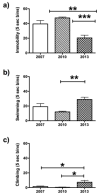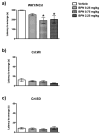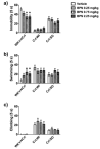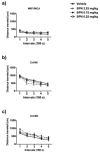Antidepressant-like effects of buprenorphine in rats are strain dependent
- PMID: 25453747
- PMCID: PMC4382376
- DOI: 10.1016/j.bbr.2014.10.014
Antidepressant-like effects of buprenorphine in rats are strain dependent
Abstract
The prevalence of major depressive disorder and the limited efficacy of conventional drug treatments provide significant impetus to develop novel and more rapidly acting antidepressants for individuals with treatment resistant forms of depression. The primary goal of these studies was to ascertain whether buprenorphine (BPN), a medically available drug with mixed effects at opioid receptors, was effective in behavioral tests using the Wistar Kyoto (WKY) rat strain, a rodent model of exaggerated depressive and anxiety behaviors that demonstrates resistance to certain antidepressants. As WKY rats are maintained by different sources, we assessed the behavioral effects of BPN using the modified rat forced swim test (FST) and the emergence test in WKY rat colonies obtained from different vendors. BPN dose-dependently reduced immobility and increased swimming behavior in the FST and reduced emergence latencies in two WKY lines (Charles River (WKY/NCrl) and Harlan laboratories (WKY/NHsd)) that also showed high baseline immobility in the FST. WKY rats from Taconic (WKY/NTac) did not show high baseline immobility in the FST or anxiety as had been previously reported, suggesting a drift in the phenotype of rats from this supplier. Furthermore, BPN did not reduce immobility in the FST or reduce latencies in the emergence test in WKY rats from Taconic. BPN also failed to produce antidepressant-like effects in Wistar and Sprague-Dawley rats. These results indicate a striking strain-selectivity for the effects of BPN, producing antidepressant and anxiolytic-like responses in WKY/NCrl and WKY/NHsd lines but not in the normosensitive control Wistar and Sprague-Dawley strains.
Keywords: Buprenorphine; Emergence test; FST; Treatment-resistant depression; Wistar Kyoto rat.
Copyright © 2014 Elsevier B.V. All rights reserved.
Conflict of interest statement
The authors declare that the research was conducted in the absence of any commercial or financial relationships that could be construed as a potential conflict of interest.
Figures






References
-
- Trivedi MH, et al. Medication augmentation after the failure of SSRIs for depression. N Engl J Med. 2006;354(12):1243–52. - PubMed
-
- Fava M, et al. Difference in treatment outcome in outpatients with anxious versus nonanxious depression: a STAR*D report. Am J Psychiatry. 2008;165(3):342–51. - PubMed
-
- Trivedi MH, et al. Clinical evidence and potential neurobiological underpinnings of unresolved symptoms of depression. J Clin Psychiatry. 2008;69(2):246–58. - PubMed
-
- Olchanski N, et al. The economic burden of treatment-resistant depression. Clin Ther. 2013;35(4):512–22. - PubMed
Publication types
MeSH terms
Substances
Grants and funding
LinkOut - more resources
Full Text Sources
Other Literature Sources
Medical
Research Materials
Miscellaneous

